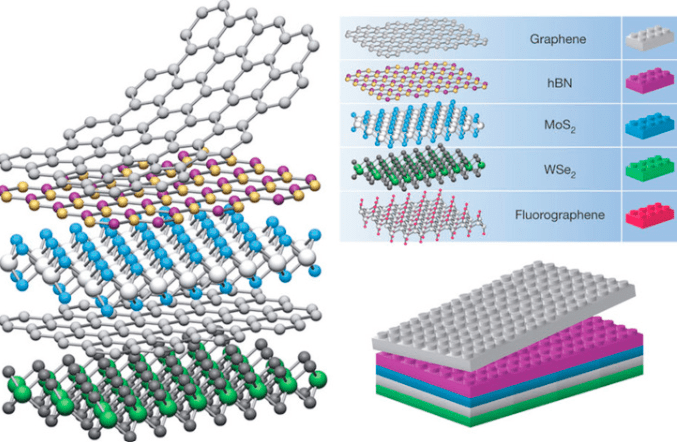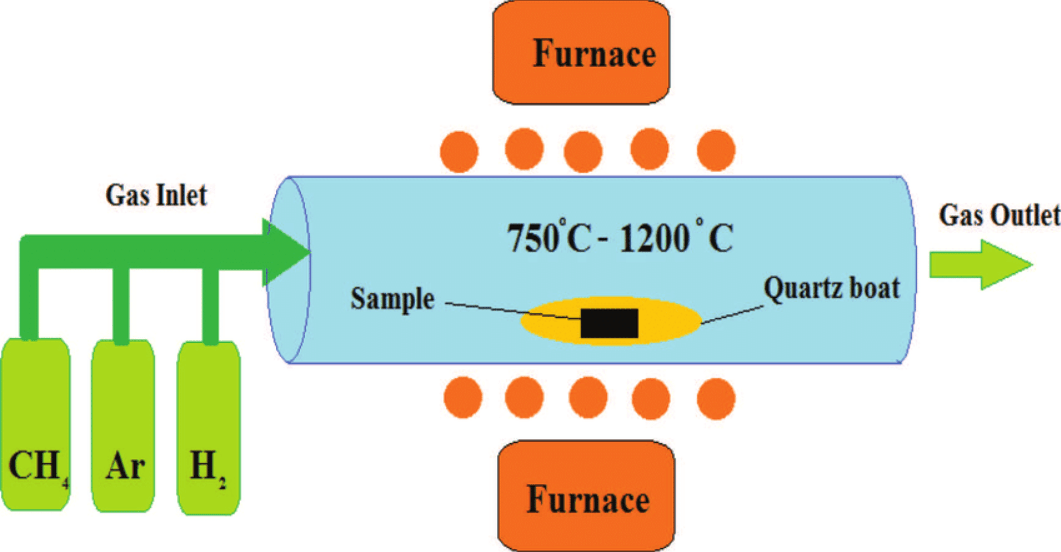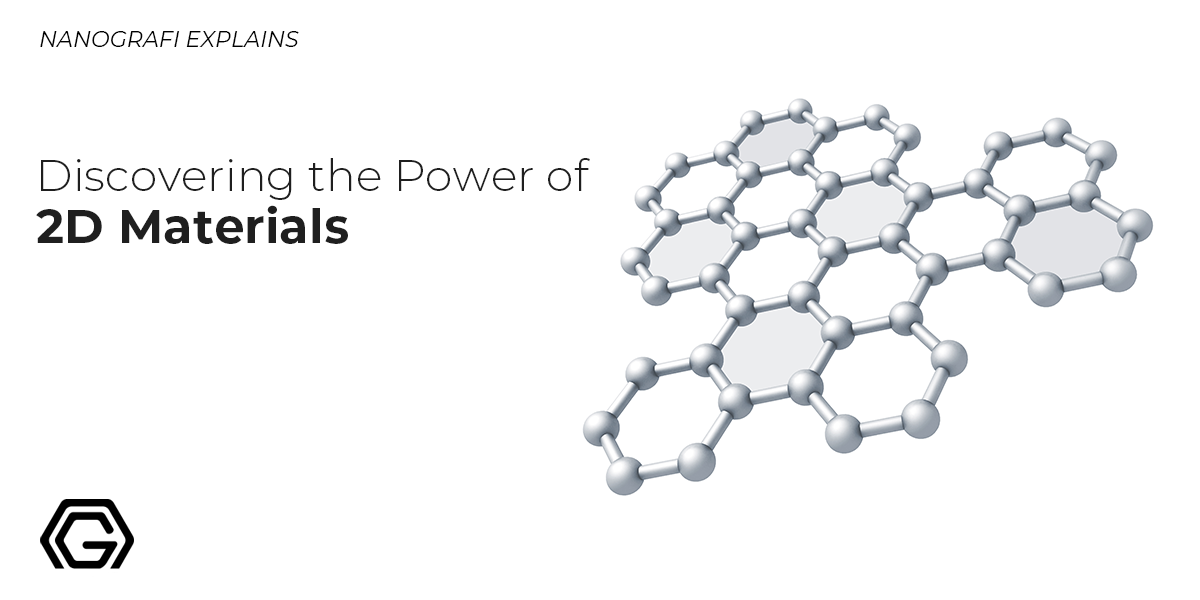Discovering the Power of 2D Materials
In material science, the discovery of two-dimensional (2D) materials represents a transformative development, bridging scientific curiosity and technological breakthroughs. Characterized by their atomically thin structure, these materials unveil new possibilities in electronics, photonics, and energy storage, marking a pivotal moment in both research and application.
The unique properties of 2D materials, such as remarkable electrical conductivity, mechanical strength, and flexibility, make them ideal for a wide range of applications. Innovations, like the one from researchers at Rice University, which allows for real-time observation and control over the growth of 2D crystals, not only enhance production efficiency but also deepen our understanding of their fundamental formation. This breakthrough underscores the vast potential of 2D materials to revolutionize various technological domains. In the context of these advancements, Nanografi emerges as a critical player, providing a spectrum of nanomaterials that are integral to furthering research and development in the field of 2D materials.
Introduction
Material science stands at the cusp of a revolution, with the synthesis and application of 2D materials at its core. These materials, often just one atom thick, exhibit properties that could redefine the limits of current technology and pave the way for future innovations.
What Are 2D Materials?
Two-dimensional (2D) materials consist of extremely thin layers that extend in two dimensions with almost no thickness in the third dimension. These materials possess unique and distinct properties due to their ultra-thin structure, which can be just a few atoms thick at the atomic or molecular level. With a flat surface at the atomic scale, these materials exhibit differences in electronic, optical, and mechanical properties compared to traditional materials.
The most well-known example of 2D materials is graphene. Graphene has a two-dimensional structure where carbon atoms are arranged in a honeycomb pattern. It is renowned for its exceptional electrical conductivity, high mechanical strength, and unique thermal properties. The discovery and development of graphene have encouraged scientists to explore and research other 2D materials. Materials such as phosphorene, molybdenum disulfide (MoS2), and hexagonal boron nitride (h-BN) also display similar ultra-thin structures, offering potential for use in electronics, photovoltaic applications, and sensors, among many other areas.

Figure 1. Schematic diagram of a hetero-structured 2D material.
How 2D Materials Are Synthesized?
At its core, the synthesis of 2D materials involves the delicate orchestration of atoms into layers just one atom thick, manifesting unique properties that are not found in their bulk counterparts. The traditional workhorse for this task has been the CVD technique. CVD operates on the principle of depositing gaseous reactants onto a substrate, where they undergo a series of chemical reactions to form a solid material. The process demands meticulous control over numerous parameters: temperature must be finely tuned to facilitate the desired reactions; pressure must be carefully managed to ensure the correct gas phase conditions; and the chemical precursors must be precisely balanced to yield the targeted material.
However, these requirements underscore the primary challenges in 2D material synthesis: consistency and scalability. Achieving uniformity across a substrate is notoriously difficult, with slight variations in conditions leading to significant discrepancies in material quality. Moreover, scaling up this process while maintaining high quality remains a daunting task, limiting the practical applications of 2D materials.

Figure 2. Schematic illustration of CVD method of graphene synthesis.
Overcoming Synthesis Challenges
Despite their potential, synthesizing 2D materials with consistency and scalability remains a challenge. Traditional chemical vapor deposition (CVD) techniques require precise control over temperature, pressure, and chemical precursors. The development at Rice University signifies a breakthrough in this area, offering a glimpse into the future of 2D material production.
Breakthrough at Rice University
At Rice University, researchers have introduced a groundbreaking system that enables the real-time observation of 2D crystal growth. This method, leveraging advanced image processing and machine learning algorithms, allows scientists to monitor and adjust the synthesis process on the fly, ensuring higher quality and consistency of 2D materials.
Case Study
Synthesizing Molybdenum Disulfide (MoS2) Molybdenum disulfide, a promising 2D material, has been successfully synthesized using the new system developed at Rice. This process highlights the potential for controlled growth of high-quality 2D crystals, opening doors to scalable production for commercial applications.
Uses of 2D Materials
The unique characteristics of two-dimensional (2D) materials, which include remarkable electrical conductivity, impressive mechanical strength, and notable flexibility, position these materials as catalysts for technological innovation. The synthesis and manipulation of these atomically thin substances have the potential to significantly advance a variety of fields, from electronics to energy storage, and from healthcare to environmental protection:
Electronics and Computing
Particularly graphene among 2D materials has made significant advancements in electronics and computer technologies. The high electrical conductivity and flexibility of these materials enable the development of ultra-fast and energy-efficient devices, as well as innovative products like wearable technologies and foldable screens.The use of graphene and similar 2D materials in computer processors has the potential to increase processing power and efficiency, though comprehensive commercial applications in this area are still under development.
Transformative Energy Solutions
In the energy sector, 2D materials, especially in energy storage and solar panels, have led to notable advancements. Graphene-based supercapacitors and batteries, with their high energy storage capacity and rapid charging rates, stand out as promising candidates for future energy storage solutions. Similarly, the use of graphene and other 2D materials in solar panels has made significant progress in efficiently capturing and utilizing solar energy. The application of these materials has the potential to produce lighter, more flexible, and efficient solar cells.
Medical Applications
In the medical field, certain 2D materials, due to their compatibility with biological systems, are used in areas such as drug delivery systems, biosensors, and tissue engineering. Specific applications, like targeted drug delivery for cancer treatment, are being developed by leveraging the unique properties of these materials. Additionally, 2D materials enable the development of sensitive biosensors for early disease diagnosis and tissue engineering applications that can assist in repairing damaged tissues.
The advancements in these areas demonstrate the potential of 2D materials and promise broader applications in the future. However, significant research and development efforts are required to commercialize and scale these technologies for industrial use.
Graphene, with its capabilities to diagnose diseases earlier and to show the inside of the body in more detail, is a significant material in the field of medicine. To learn more, read the blog.
Photonic and Optical Innovations
Due to their unique optical properties, 2D materials are poised to transform photonic devices, including highly sensitive sensors and new laser technologies. Their ability to absorb and process light across a broad spectrum while retaining transparency offers opportunities for enhancing solar cell efficiency and developing advanced imaging technologies.
Environmental Applications
2D materials also play a significant role in environmental sustainability. For example, their use in water purification with graphene-based filters could offer more effective solutions to global water pollution challenges. Furthermore, their sensitivity to various chemicals positions them as ideal for pollutant detection, aiding in real-time environmental monitoring and protection.
Overall, the extensive potential of 2D materials extends across and beyond their current applications, touching upon every aspect of technological progress and innovation. As continued research seeks to uncover and utilize their full capabilities, we can expect a series of groundbreaking developments that will redefine industries ranging from electronics and energy to healthcare and environmental science, marking a new era in materials science.
Conclusion
The advent of two-dimensional (2D) materials marks a significant leap forward in material science, bridging the gap between theoretical curiosity and practical innovation. These materials, notable for their ultra-thin structure and exceptional properties, are forging new paths in fields ranging from electronics to energy, and healthcare to environmental protection.
Breakthroughs, such as those achieved by researchers at Rice University, promise to overcome production challenges, enhancing both quality and scalability. As we delve deeper into the potential of 2D materials, we stand at the cusp of a technological revolution that could redefine industries and offer sustainable solutions to global challenges, heralding an exciting future of endless possibilities.
One of the world's highest-performing graphene production facilities, Nanografi, continues to support research with its high-quality products.
References
Chemical Vapor Deposition CVD Graphene - Nanografi Nano Technology. (n.d.). Retrieved March 19, 2024, from https://nanografi.com/blog/chemical-vapor-deposition-cvd-graphene/
Graphene Batteries as Promising Battery Technology - Nanografi - Nanografi Nano Technology. (n.d.). Retrieved March 19, 2024, from https://nanografi.com/blog/graphene-batteries-as-promising-battery-technology-nanografi/
Graphene Water Filtration - Nanografi Nano Technology. (n.d.). Retrieved March 19, 2024, from https://nanografi.com/blog/graphene-water-filtration/
Ji, L., Zou, X., Hsu, H.-Y., Huang, K., Gao, N., Zhu, H., Chen, L., Sun, Q., Zhou, P., & Zhang, D. W. (2020). Two-dimensional materials as photoelectrodes in water reduction devices for energy applications. Emerging 2D Materials and Devices for the Internet of Things, 165–179. https://doi.org/10.1016/B978-0-12-818386-1.00007-2
Medical Applications of Graphene - Nanografi Nano Technology. (n.d.). Retrieved March 19, 2024, from https://nanografi.com/blog/medical-applications-of-graphene/
Molybdenum Disulfide (MoS2) Properties and Applications - Nanografi Nano Technology. (n.d.). Retrieved March 18, 2024, from https://nanografi.com/blog/molybdenum-disulfide-mos2-properties-and-applications/
Schematic illustration of CVD method of graphene synthesis. | Download Scientific Diagram. (n.d.). Retrieved March 19, 2024, from https://www.researchgate.net/figure/Schematic-illustration-of-CVD-method-of-graphene-synthesis_fig1_334610124
Scientists develop a new system to record 2D crystal synthesis in real time. (n.d.). Retrieved March 18, 2024, from https://www.nanowerk.com/nanotechnology-news3/newsid=64861.php
Scientists develop new system to record 2D crystal synthesis in real time. (n.d.). Retrieved March 18, 2024, from https://phys.org/news/2024-03-scientists-2d-crystal-synthesis-real.html
Two Dimensional Materials for Computing Technology - Nanografi Nano Technology. (n.d.). Retrieved March 19, 2024, from https://nanografi.com/blog/two-dimensional-materials-for-computing-technology/
What a view: Rice scientists develop a new system to record 2D crystal synthesis in real time | Rice News | News and Media Relations | Rice University. (n.d.). Retrieved March 18, 2024, from https://news.rice.edu/news/2024/what-view-rice-scientists-develop-new-system-record-2d-crystal-synthesis-real-time
What is Graphene: The Ultimate Guide - Nanografi Nano Technology. (n.d.). Retrieved March 18, 2024, from https://nanografi.com/blog/what-is-graphene-the-ultimate-guide/
Recent Posts
-
Advanced Materials for Unmanned Aerial Vehicle (UAV) Protection Against Laser
Consider a UAV on a critical mission, rendered inoperative by a sudden laser attack. With the increa …26th Jul 2024 -
Simulation and Modeling of Material Properties
Our world is composed of a dazzling array of materials, each with its own unique properties that dic …19th Jul 2024 -
Advanced Coatings for Superior Corrosion and Wear Resistance
Corrosion and wear pose significant challenges across various industries, leading to substantial eco …12th Jul 2024






